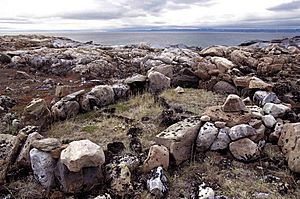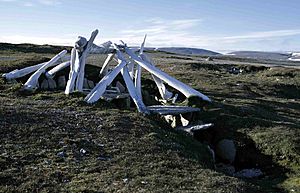Qarmaq facts for kids
A Qarmaq (say "CAR-mack") is a special type of home used by the Inuit people. The word "qarmat" is the plural form. These homes were used during the changing seasons, like spring and fall. They were usually a single room, big enough for one family.
For the Central Inuit in Northern Canada, a qarmaq was a mix of a tent and an igloo, or a tent and a sod house. The bottom part was made of snow blocks or stone, depending on the time of year. The top part was covered with animal skins or canvas. In Greenland, the word qarmaq refers to just the wall of the home. Qarmaqs were built with round walls of stone, sod, or snow blocks. They had a frame, often made from animal bones, which was then covered with skins.
Contents
A Look Back: History of Qarmaqs
Inuit families used qarmaqs for a very long time, up until the 1950s. People like the Thule people, who were ancestors of the Inuit, used them many centuries ago. Qarmaqs were especially popular during the colder parts of the year. While traveling in winter, Inuit might stay in igloos. But if they could, they preferred the qarmaq for a more permanent home.
How Qarmaqs Were Built
Building a qarmaq was a team effort for the whole family. They had to pick the right spot. This meant understanding the land and how the weather would affect the home.
Building a Snow Qarmaq
- Men's Role: The men would gather and fit together large stones and bones for the frame. Since there wasn't much wood, whale bones were often used for the frame.
- Women and Children's Role: Women and children collected moss from the tundra. This moss was used to fill any gaps in the walls. They also prepared animal skins for the roof and sides.
- Adding Snow: Once winter snow arrived, the men would cut large blocks of snow with long knives. They placed these blocks around the outside of the qarmaq for extra protection.
- Repairs: If the outer snow walls were damaged by weather or animals like wolves, the women would patch them up. They often did this in freezing cold and windy conditions.
Building a Sod Qarmaq
During the summer, Inuit used tents that were easy to move. But when fall arrived, these tents were replaced by sod qarmaqs. These homes used sod (grass and soil) for their walls, making them warmer for the cooler seasons.
Inside a Qarmaq
Inside a qarmaq, the main source of warmth came from a special lamp called a qulliq. This lamp burned oil, usually from seals or whales. The sleeping area was slightly raised off the ground. It was made more comfortable with soft caribou skins used as padding.



